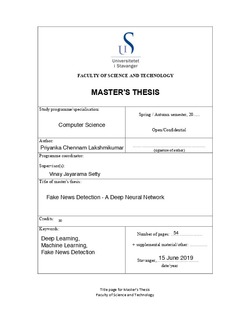| dc.contributor.advisor | Setty, Vinay Jayarama | |
| dc.contributor.author | Chennam Lakhsmikumar, Priyanka | |
| dc.date.accessioned | 2019-10-07T08:15:41Z | |
| dc.date.available | 2019-10-07T08:15:41Z | |
| dc.date.issued | 2019-06-15 | |
| dc.identifier.uri | http://hdl.handle.net/11250/2620529 | |
| dc.description | Master's thesis in computer science | nb_NO |
| dc.description.abstract | News is an important source of information for people.Identifying the inaccurate news is a difficult problem.
Fake news, defined by the New York Times ”as a made-up story with an intention to deceive”, often for a secondary gain, is arguably one of the most serious challenges facing the news industry today.
In this world of busy schedules, none of us have enough time to verify the source of all the news articles. This is a difficult and time taking procedure. Of all the challenges in the widespread of fake news, different types of fake news are a major challenge.
Fake news is a major threat which is basically formed by all forms of false, inaccurate or misleading information. The goal of the Fake News Detection is to explore how machine learning and natural language processing, might be useful to address the fake news problem.
One application that we will explore in this paper is to use Machine Learning techniques to determine whether a pair of news statements agrees, disagrees, or is unrelated to another i.e
The input would be a corpus of news statement pairs and the output will be the classification of the statements on the basis of whether they both agree, disagree, or are unrelated.
We developed several deep neural network-based models to tackle the fake news detection problem, ranging from relatively simple feed-forward networks to elaborate models featuring attention and multiple feature fusion technique using pre-trained GloVe word embeddings.
Our approach learns two representations, one based on attention [2] to decompose the problem into subproblems that can be solved separately, thus making it trivially parallelizable and another based on sequential composition (LSTM) with pre-trained GloVe word embeddings. Both views are used for prediction.
Our models are shown to be efficiently classifying the corpus of statement pairs in a set of experiments using the ByteDance dataset | nb_NO |
| dc.language.iso | eng | nb_NO |
| dc.publisher | University of Stavanger, Norway | nb_NO |
| dc.relation.ispartofseries | Masteroppgave/UIS-TN-IDE/2019; | |
| dc.subject | informasjonsteknologi | nb_NO |
| dc.subject | maskinlæring | nb_NO |
| dc.subject | machine learning | nb_NO |
| dc.subject | deep learning | nb_NO |
| dc.subject | fake news detection | nb_NO |
| dc.subject | datateknikk | nb_NO |
| dc.subject | datateknologi | nb_NO |
| dc.title | Fake News Detection A Deep Neural Network | nb_NO |
| dc.title.alternative | Fake News Classification | nb_NO |
| dc.type | Master thesis | nb_NO |
| dc.subject.nsi | VDP::Technology: 500::Information and communication technology: 550 | nb_NO |
